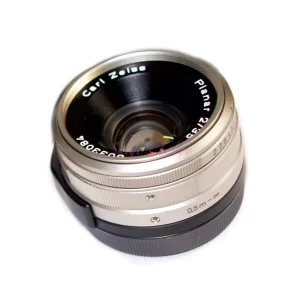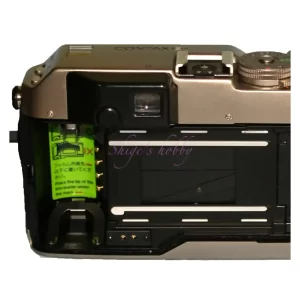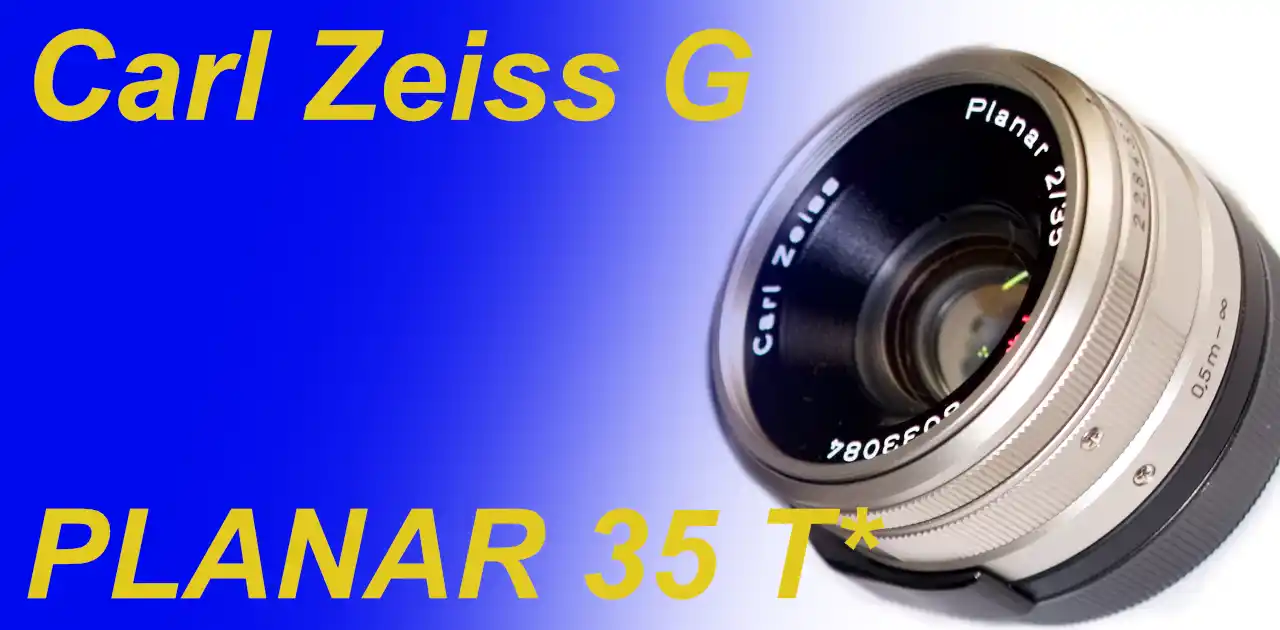Last updated on 2025-09-25
A review and sample photos of the CONTAX G PLANAR T* 35mm used with the dedicated autofocus rangefinder camera CONTAX G1.
- Please see the disclaimer regarding advertising here.
- Italicized links in the text are advertisement links that take you to other sites.
Table of contents
Gallery
The sample photos were taken using a CONTAX G1 camera body, AGFA CT Precisa 100 film, and a NIKON COOLSCAN V ED film scanner.
Review

1.Overview
The CONTAX G PLANAR T* 35mm is an autofocus lens for the CONTAX G released in 1996.
Its main specifications are a focal length of 35mm, maximum aperture of F=2, and a minimum shooting distance of 0.5m.
To use the CONTAX G PLANAR T* 35mm and BIOGON G 21mm F2.8 lenses, which were released with the CONTAX G2, with the CONTAX G1, you will need to apply the CONTAX G1 ROM update service to your camera.
To determine if your camera has the updated ROM, open the film chamber and check if there is a green label.
As of 2025, this update service has already ended.

2.Usability
I used the CONTAX G PLANAR T* 35mm with the CONTAX G1 (ROM updated) and G2.
Autofocus is available for focusing, and the appropriate shooting range is displayed in the viewfinder of the CONTAX G1 and CONTAX G2.
Using manual focus is troublesome, as there is no distance display on the lens barrel, and you rely on the rangefinder displayed in the camera’s viewfinder, and adjust the shooting distance using the focus ring on the top of the camera for the G1 and the focus ring on the front of the camera for the G2.
The autofocus focus position is not very reliable.
Even when using manual focus, you need to determine the distance from the subject, and since there is no way to determine whether it is appropriate, I rarely used manual focus.
The Planar 35mm is designed so that the double Gauss type rear lens is distant from the film surface, so the TTL (Through the Lens) actual aperture metering (center-weighted average metering) of the original CONTAX G series body determined the exposure with satisfactory accuracy.
As the name Planar suggests, the image surface is flat and there is no complaint about the resolution when shooting negative film.
The resolution is not sharp but creates a soft image.
There is also no light falloff in the peripheral areas, making it an easy lens to use.
A dedicated hood is provided as a 46mm screw-in GG-1. I left the small hood on, so I have not confirmed the difference with and without the hood. I rarely saw any suspicious light in backlit situations while shooting, so the T* coating on the lens may be working.
Examples of lenses modified by Ms-optics are posted below, taken with a digital camera.

3.Summary
In conclusion, to sum up the CONTAX G PLANAR T* 35mm, if you shoot with the film cameras CONTAX G1 and G2, this 35mm is a must-have lens. This one lens is versatile enough to handle almost any purpose. I can’t help but suspect that the reason it wasn’t included in the initial lens lineup was because it would be a problem if you could get by with just this one lens. The image quality is absolutely fine for use with a film camera.
However, if you use it with a digital camera such as a mirrorless camera, it’s a bit tricky, and the price of over 50,000 yen in the 2020s is too expensive to invest in an old lens. If it’s less than 30,000 yen, I think it’s worth investing in.
If you’re looking for a reason to buy it, the size of this lens is compact and attractive, and if you like the design of the lens, there’s no reason to deny the purchase as it will increase your desire to take photos.
Side Talk
There are only a few 35mm lenses with the Planar name for 35mm format, and the only other lenses are the Planar 35mm F3.5 for the old CONTAX. Other Carl Zeiss lenses with a focal length of 35mm are called Biogon or Distagon.
Lenses with the Planar name are often used as standard lenses with focal lengths of 50mm to 80mm.
When we look into why we don’t see many Planar lenses with a focal length of 35mm, we find that the reference link “Nikkor One Thousand and One Nights Tale 37th Night W-Nikkor 3.5cm F2.5” states that “For a Gaussian type to achieve good performance, the limit is an angle of view of 60 to 70 degrees” (end of quote), and the diagonal angle of view of 63 degrees for a focal length of 35mm is close to the limit mentioned above.
Therefore, rangefinder cameras tend to use the Biogon format because they can tolerate the rear lens group approaching the film plane, while SLR cameras tend to use the retrofocus format when lens performance is required because they are tolerant of lens size.
This is thought to be the reason why there are few planar formats with a focal length of 35mm.
Here, I would like to explain the marketing-driven lens lineup balance theory as the reason why Kyocera CONTAX adopted the planar format for 35mm.
At the time of the release of the CONTAX G1, the lens lineup included Carl Zeiss’s representative lens formats, including the Hologon 16mm, Biogon 28mm, Planar 45mm, and Sonnar 90mm, making it a well-thought-out lens lineup to celebrate the release of the new camera and lens.
The lenses released for the CONTAX G2 will be 21mm, 35mm, and 35-70mm zoom.
In that case, if the 21mm and 35mm were in the Biogon format, the release of the new lenses would be marked as BIOGON 21mm, BIOGON 35mm, and VARIO SONNAR 35-70mm.
The Biogon format would continue throughout the lens lineup with 21mm, 28mm, and 35mm, and when listed as in the table below, the lens lineup would seem unbalanced.
Therefore, by using the planar format for the 35mm, the release of the new lenses would be BIOGON 21mm, PLANAR 35mm, and VARIO SONNAR 35-70mm, which would improve the balance when listed.
Considering lens performance, it seems reasonable to use the Biogon for the 35mm. However, perhaps the planar format was adopted from a marketing perspective?
The ZM series of 35mm focal length lenses for rangefinder cameras and Leica M-mount cameras released in the 2000s consisted of three lenses: the BIOGON T* 35mm F2 ZM, the C BIOGON T* 35mm F2.8 ZM, and the DISTAGON T* 35mm F1.4 ZM. It is interesting that Kyocera and CONTAX adopted the Planar lens for the 35mm G series.
Of course, Kyocera must have considered the possibility of the BIOGON 35mm, and if the CONTAX G series had continued and additional lenses had been released, the BIOGON 35mm F2.8 may have been one of them.
| Lens lineup when 35mm is BIOGON | Lens lineup at time of release | |
| 16mm | HOLOGON | HOLOGON |
| 21mm | BIOGON | BIOGON |
| 28mm | BIOGON | BIOGON |
| 35mm | BIOGON | PLANAR |
| 45mm | PLANAR | PLANAR |
| 90mm | SONNAR | SONNAR |
| 35-70mm | VARIO SONNAR | VARIO SONNAR |
Specification and Competitor
| Item | PLANAR | PLANAR | BIOGON |
| focal length(mm) | 35 | 35 | 35 |
| Maximum aperture | 2 | 3.5 | 2 |
| Minimum aperture | 16 | 22 | 22 |
| Leaf blade | 7 | 9 | 10 |
| Lens configuration | 7 elements in 5 groups | 5 elements in 4 groups | 9 elements in 6 groups |
| Minimum distance(m) | 0.5 | 0.9 | 0.7 |
| Lens length(mm) | 31.5 | – | 43 |
| Lens max diameter(mm) | 56 | – | 52 |
| Filter type | 46 | – | 43 |
| Weight(g) | 160 | – | 240 |
| Hood | GG-1 | – | Carl Zeiss Lens Shade 35mm/50mm |
| Lens mount | CONTAX-G | Old CONTAX | ライカM |
| Release date | 1996 | 1932 | 2005.3.25 |
| Price | ¥47,000 | – | ¥95,000 |
Reference links
- Wikipedia’s explanation of the Contax G
- DISTAGON T*1,4/35 ZM ・Cosina official page
- BIOGON T*2/35 ZM・Cosina official page
- BIOGON T*2.8/35 ZM・Cosina official page
- CONTAX G PLANAR 35mm Ms-optics modified lens・Shige’s hobby
- CONTAX G2・Shige’s hobby
- CONTAX G1・Shige’s hobby
- Carl Zeiss BIOGON T* 35mm F2・Shige’s hobby
- Tale of the Nikkor Thousand and One Nights: Night 37 W-Nikkor 3.5cm F2.5
Update history
- 2025.5.1
Affiliate links
- G PLANAR 35mm・Ads by ebay
- PLANAR 35mm・Ads by Amazon
- CONTAX PLANAR・Ads by Amazon
- Carl Zeiss lens shade 35mm/50mm・Ads by Amazon
- Carl Zeiss Biogon T* 2 / 35 ZM ・Ads by Amazon
- Carl Zeiss C Biogon T*2.8/35 ZM・Ads by Amazon




![[商品価格に関しましては、リンクが作成された時点と現時点で情報が変更されている場合がございます。] [商品価格に関しましては、リンクが作成された時点と現時点で情報が変更されている場合がございます。]](https://hbb.afl.rakuten.co.jp/hgb/129f17dc.27f0c9d8.129f17dd.01c38374/?me_id=1296072&item_id=14629250&pc=https%3A%2F%2Fthumbnail.image.rakuten.co.jp%2F%400_mall%2Fkomehyo-online%2Fcabinet%2F10196%2F2600071727226_b.jpg%3F_ex%3D128x128&s=128x128&t=picttext)
![[商品価格に関しましては、リンクが作成された時点と現時点で情報が変更されている場合がございます。] [商品価格に関しましては、リンクが作成された時点と現時点で情報が変更されている場合がございます。]](https://hbb.afl.rakuten.co.jp/hgb/0f8addca.6e306624.0f8addcb.b7dc3dde/?me_id=1191940&item_id=11735028&pc=https%3A%2F%2Fthumbnail.image.rakuten.co.jp%2F%400_mall%2Fnaniwa%2Fcabinet%2Fseco_sku24%2F2221070411413-01.jpg%3F_ex%3D128x128&s=128x128&t=picttext)
Be First to Comment